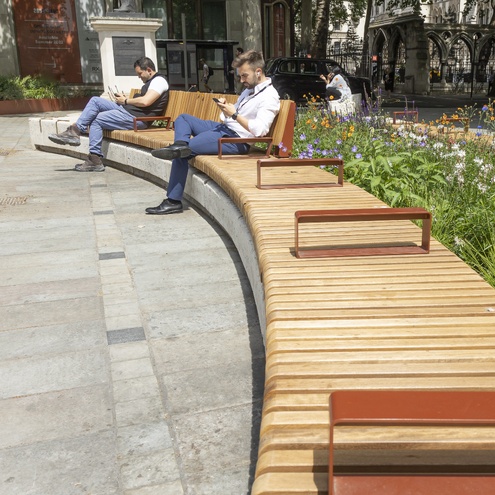Project showcase
Strand Aldwych Public Realm, Westminster – Westminster City Council with LDA Design

After the dramatic removal of traffic and pedestrianisation of the Strand in 2021, a safer and calmer space has emerged. Multi-coloured seating lines a large performance space with programming commissioned by the surrounding arts institutions. Communal dining, flowerbeds, new trees and cycle stands have increased dwell time in a previously busy and dense section of the city.
Who is on the project team?
Client: Westminster City Council
Lead Designer/Landscape Architect:LDA Design
Civil Engineering and Highways:WSP
Transport:NRP
Lighting Design:Michael Grubb Studio
The initial vision was set in motion by the Northbank Bid with Publica.
Key Stakeholders: Northbank Bid, Somerset House, Kings College, Courtauld Gallery, Store Studios, Hotels, Theatreland, local businesses, London School of Economics, Indian and Australian Embassies, Church of England, local schools and Covent Garden.
Describe the context of this project and its neighbourhood and people?
Strand Aldwych is lined with exceptional buildings and institutions, including Somerset House, the Courtauld Institute, Bush House, King’s College, and LSE; west is theatreland and Covent Garden. Although strategically important, the area has long been difficult to love; somewhere writer Richard Brown says is easy to shrug off as an interspace. In fact, Strand (or Strond, meaning edge of river) has been an important east/west route since AD190 and it remains a key processional route between Westminster Abbey and St Paul’s. Completed in 1905, Aldwych is younger, and inspired by Parisian boulevards. Combined, they formed a one-way gyratory which turned Grade 1* St Mary Le Strand Church, described by journalist Simon Jenkins as “the finest 18th century church in London”, into a traffic island known by bus drivers as ‘St Mary in the Way’.
Heavy traffic, bus logjams and narrow pavements meant Strand was a crowded, polluted, hostile place for pedestrians and cyclists. Local businesses suffered from the scurry. Westminster Cllr Geoff Barraclough described Aldwych as “awful for pedestrians who would take their life into their own hands getting from one side to the other.”
Tell us what you did and how the project enlivened the place?
Traffic change was key to reclaiming space for people and nature. Westminster City Council commissioned LDA to create a welcoming landscape where people could enjoy their surroundings for the first time. In 2021, traffic was removed on Strand from Waterloo Bridge to St Clement Danes – hush fell. Aldwych became two-way, slower, and safer with five signalised pedestrian crossings. Design ideas were workshopped, tested, and shaped with 70 stakeholders. Events like ‘September on the Strand’, featuring a skatepark and outdoor dining, enabled people to experience the difference. In December 2022, Strand was officially opened with new trees and views, communal dining, flowerbeds, and rain gardens. Multi-coloured seats edge a generous performance space, with Somerset House and St Mary le Strand as backdrop. St Clement Danes Garden features elegant Portland Stone benches that respond to the church’s bomb-damage history; paving is inspired by the church’s flooring.
Did the project make a positive social and environmental contribution?
The £22m reimagining of Strand Aldwych is designed to better meet the daily needs of a community comprising students, academics, visitors, office workers, residents, and businesses. It has created inclusive public realm where there was none and made a notoriously treacherous road safer and more accessible.
Car free, Strand is now a destination, a social space supporting creative exchange and cross-pollination of ideas, so knowledge is shared not stored away. It can host art installations, festivals, and events for the first time. For residents, students, and workers it will improve quality of life, transform air quality, and provide respite and quality green space. Now, there is a generous platform for a lively programme of commissions brought forward by the neighbouring institutions. First is ‘The Voiceline’, an installation using archived recordings to mark 100 years since the first BBC broadcast from Bush House. More will follow. Flexibility in design leaves space for the unknown.
Strengthening the area’s strategic importance and wider connectivity, stronger pedestrian and cycling links have improved access to Covent Garden, Holborn, the West End, and to the Thames and Embankment. Adjacent roads have narrowed to widen footways, and street clutter is reduced. There are crossings on desire lines. Journey times along Aldwych are shorter.
Dwell time has significantly increased, and traffic is calmed. Canon Peter Babington, priest-in-charge at St Mary le Strand, reports a spike in visitors. He now anticipates around 50,000 visits a year and has successfully secured HLF funding. Marking the new dawn, a sound and light installation has opened in the church. Environmental benefits include supporting pollinators, cooling urban heat and improved air quality. There are 41 new trees and 1,370m2 of biodiverse planting, which provides year-round colour and interest and creates permeable surfaces to better manage heavy rainfall. Engagement with local stakeholders will pursue further greening opportunities. 150+ well-positioned cycle stands (50 new) support cyclists.
Festival of Pineapples
24-26 February 2026
Pineapples prize giving night
April
Pineapples at Festival of Place
10 June 2026
© The Pineapples - Tweak Ltd. 124 City Road, London, EC1V 2NX. Tel: 020 3326 7238




